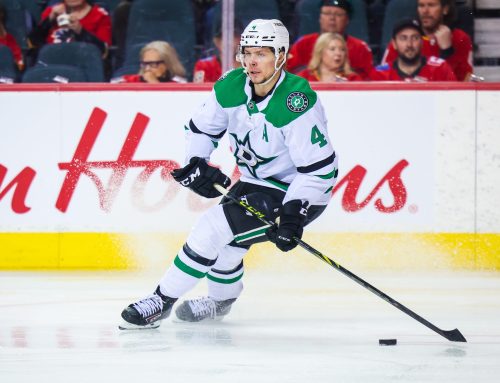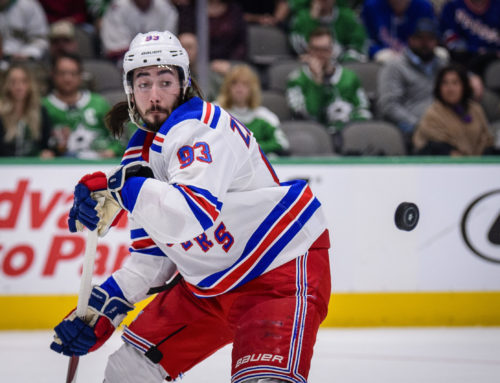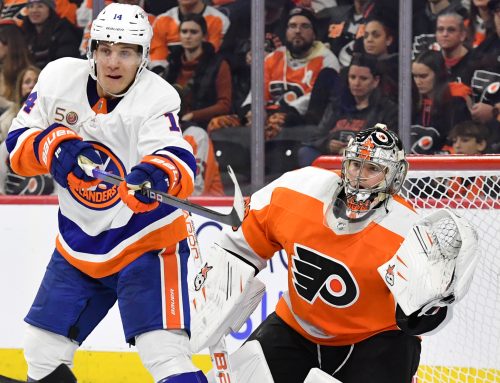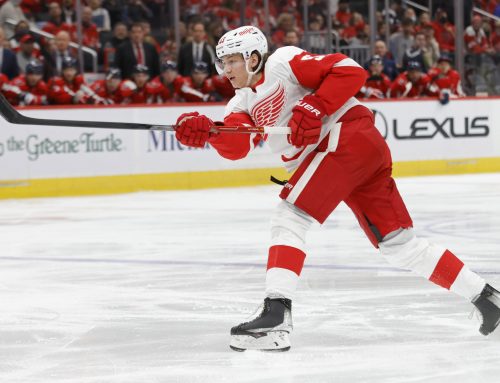Goldipucks and the Three Skaters: Nick Suzuki, Valeri Nichushkin and Robert Thomas
Rick Roos
2024-02-07
Welcome back to Goldipucks and the Three Skaters, a play on words of the Goldilocks and the Three Bears story. Instead of there being three bowls of porridge though, I cover three skaters and declare one too hot (i.e., doing unsustainably better than he should), another too cold (i.e., doing unsustainably worse), and a third “just right” (i.e., producing where he should be). In addition, I also assign each a rating of 1-10, indicating how hot (rated 7-10, where 10 is the most unsustainably hot), cold (rated 1-4, where 1 is the most unsustainably cold), or “just right” (rated 4-7, where 5.5 is the most “just right”) he is.
On tap for this edition are three forwards (Nick Suzuki, Valeri Nichushkin, and Robert Thomas). Be sure to test your fantasy instincts by trying to deduce which is too hot, which it too cold, and who's "just right," and then read on to find out how many of the three you got correct. If you'd like some bonus Goldipucks analysis, be sure to give a listen to the episode of the Keeping Karlsson podcast on which I recently appeared and which featured a Goldipucks segment. As for the three players being covered here, all their stats are current through the all star break.
Nick Suzuki (49 GP, 13 G, 29 A, 110 SOG, 21:08 TOI, 22 PPPts, 3:38 PP, 68.0% PP%)
The former first rounder somewhat surprisingly spent two more seasons in juniors after being drafted, but then went directly to the NHL, as the Habs were in dire need of all the talent they could get. What has Suzuki done since arriving? Only seen both his scoring rate and TOI increase with each season, although less so of late. Is he at his ceiling, at least until the Habs improve? While it is likely we won't see the best of Suzuki until if/when Montreal starts scoring more as a team, he's indeed a true talent who likely will do even better as this season unfolds.
While it is true that Suzuki already is at or close to being maxed out in terms of ice time, standing ninth among all forwards, he's outside the top 30 in PP TOI and in percentage of PP minutes. Granted, he likely doesn't have much room to improve in these areas either; but Montreal averages the 12th most PP time per game of any team, up from 18th last season. So they're trending up, meaning perhaps more second half PP minutes for Suzuki.
Why is this so important? Because Suzuki thrives on the PP, tied for 11th in PPPts despite only ranking 54th in total points. Of those with more PPPts than him, only one player has less than 62 points. So clearly Suzuki's PP prowess suggests he has more in him that we've seen in terms of overall scoring. Also, although Suzuki's SOG rate is up slightly to 2.2 per game versus 2.0 last season, his PP SOG rate is vastly improved, as he has 32 already after only tallying 34 in 82 games for 2022-23. Yes, Suzuki is already getting a point on 84.6% of the PP goals scored while he's on the ice; however, Montreal as a team stands in the middle of the pack at 17th in PPGs. That is up from 28th last season, signifying that as a team they are starting to connect the dots. This should only improve over the rest of the season, with Suzuki being the main beneficiary.
Also, Suzuki, despite being a center, has only ten secondary assists out of a total of 29, for a rate of 34.5%, this after averaging 43.7% over the past two seasons. A rate of 34.5% is quite low for a center. How low? Of the 11 centers with more assists than Suzuki, their average secondary assist rate is 42.7%, meaning Suzuki ought to have several additional secondary assists already in the normal course. And over the remainder of the season he should indeed get more, boosting his scoring rate in the process.
Also, despite logging so many minutes, Suzuki's OZ% is 52.5%, up from 50.2% last season and 46.9% in 2021-22. Despite this though, his team's scoring rate at 5×5 when he's on the ice is a measly 7.3%, down from 11.4% last season and 8.1% in 2021-22. In fact, it's quite amazing he's done as well as he has thus far despite this, as no forward with a lower rate has a higher scoring pace. If Suzuki is able to even get back to his rate from 2021-22, the points should come in droves.
There's also the reality that Suzuki is a strong finisher, with 18 points in his final 20 games last season. This was despite a SOG rate under two per game, and nearly a minute less PP time per game in that quarter versus now. For 2023-24, this poises him to reach, or even best, the point per game mark over the second half.
Also, Suzuki will stand to benefit from those around him, with Cole Caufield finally starting to heat up to the tune of 12 points in his last nine games before the break, plus sophomore Juraj Slafkovsky looking more and more comfortable by the game, and scoring some to boot. In short, the ingredients are all there for a very strong second half from Suzuki.
If Suzuki was on another team that was more potent offensively, I'd wager he'd be at or near the 90 point mark, as he's a points magnet who's being held back only because he's having to supply a lot of his team's offense himself. But with Suzuki's metrics offering room for realistic improvement, and both he and his linemates poised to do better in the second half, I think he will tally at least a point per game over the remainder of 2023-24, making him TOO COLD, thus far, and earning him a rating of 2.0.
Valeri Nichushkin (40 GP, 22 G, 20 A, 129 SOG, 21:49 TOI, 16 PPPts, 4:00 PP, 65.3% PP%)
Selected tenth overall in 2013, Nichushkin was with the Stars for that entire same season, posting a decent 35-point scoring pace. Little did anyone know at the time that would be his career best scoring rate until eight seasons later, as Nichushkin failed to gain traction with the Stars, culminating in a disastrous 2018-19 that saw him score zero goals and ten assists in 57 games, leading many to think he was a bust. Although he did get a fresh start on the Avs, the results were not much better at first. All that changed though in 2021-22, when Nich rose to a 69-point pace, which he bested in 2022-23 to the tune of a 73-point pace. For 2023-24 thus far he's over the point per game mark. Is Nichushkin likely to continue to improve when he returns from his time with the Player's Assistance Program? No; in fact, his numbers indicate that he is due to come back to earth somewhat.
I was taken aback when I saw that Nichushkin is averaging nearly 22 minutes of ice time per game. Yes, some of that is shorthanded duty; however, he still has a 58.2% offensive zone starting percentage, meaning he's out there a lot and predominantly in situations that lead to him getting points. The issue is this is so far above and beyond what one would expect for a player who, until this season, has never even been a point per game producer. Also, because Nich has been in and out of the line-up his "spot" is more vulnerable than it might be for a player who is both more entrenched and durable. There's also the reality that Nichushkin is a natural right wing who's playing at LW. That's all well and good if Colorado goes the route of a "super line" with him plus Nathan MacKinnon and Mikko Rantanen; however, both Jonathan Drouin and Artturi Lehkonen are natural left wingers, such that if Colorado decides to balance out its lines there's a good chance Nichushkin is relegated to the second line. In fact, his added scoring might be what dooms him, since the team is likely to think he can help carry the second line and balance scoring.
On the plus side, Nichushkin's SOG rate is on pace to improve for the fifth straight season. To see that happening alongside him sporting a SH% of 17.0% when his average upon entering 2023-24 was 10.5%, sets off alarm bells. In fact, had Nich shot his normal rate he'd have nine fewer goals, taking a big chunk out of his scoring rate.
Further concern arises when looking just at PPGs, where he sits second in the league with 13. But his PP SOG tally of 41, though strong, only ranks him tied for 29th among forwards. Looking at players who have double digits PPGs but single digit PPAs, the list consists of Auston Matthews, for whom there isn't a concern as he's a sniper. The others are Ryan O'Reilly, Sam Reinhart, and Brock Boeser, who most would agree are overachieving.
Let's also consider that Nich is still not sporting IPPs, overall or on the PP, of even 60.0%, and in fact has never bested that mark in his career. While there is the argument it can't get much worse, clearly he is a passenger, benefitting from linemates who have far more of a nose for scoring. This is also a major concern if (when?) he does get taken off the top line, as he'd be all the less likely to score at a rate anything close to what he's showing now.
Yes, some of this "bad news" is seemingly offset by his secondary assist rate being a mere 30%. Or is it? There is such as thing as a concerningly low secondary assist rate. That signifies either he is scoring goals spoon-fed to him by more talented linemates, or he is not involved enough in the offense to find more ways to hit the scoresheet. If his IPPs were higher, for example, like Suzuki's, then this low of a secondary assist rate would be a plus. Given all the factors at play here, a low secondary assist rate is actually a worry, rather than a source of hope for more points in the normal course.
Another issue is his 5×5 team shooting percentage is 9.6% which trails that of Rantanen (10.3%) and is well behind that of MacKinnon (11.5%). Nichushkin being on that line is leading to worse production. That too could punch his ticket to the second line, especially since Drouin's is 10.4%, and the team does seem to keep coming back to using him there.
Seeing Nichushkin come from the brink of being out of the NHL to become a legitimate top-six talent is a definite feel good story. But the reality is he's not a points magnet and is more of a drag than a benefit in terms of the top line. Plus, his low IPPs and secondary assist rate suggest he just is not cut from a scoring cloth. Yet the irony is he's scored well enough that he might just buy himself a ticket to the second line, where his points could plummet. All things considered, Nichushkin has been TOO HOT and gets a rating of 9.25, as I see him as more of a 65-70 point guy than the better than point per game player he's been for 2023-24.
Robert Thomas (49 GP, 17 G, 35A, 99 SOG, 20:57 TOI, 10 PPPts, 3:12 PP, 62.8% PP%)
Also a first round pick, like Suzuki Thomas went directly from the OHL to the NHL. Upon landing, Thomas nearly produced at a point per every other game, which he followed up as a sophomore with a 52 point pace season, before faltering and dropping back to a 30 point pace in 2020-21. But Thomas exploded in 2021-22, coinciding with his 200 game breakout threshold, finishing with 76 points in 72 games. Last season he was still solid in producing at a 73 point pace, but likely was seen as a disappointment by poolies expecting more of what they saw in 2021-22. For 2023-24 however, he's back at the level he was in 2021-22. Will he be able to maintain this pace, or perhaps even improve upon it? Most likely what we're seeing now is what we should expect from Thomas.
Thomas' scoring rate of 87 points may mirror that of his 2021-22 season, but there's a major difference, namely that he's finally firing two SOG on net per game. Yes, he's barely above that rate; however, it shows he's progressing. It's also important to see because from 2000-01 to 2022-23 there were 162 instances of centers who scored at a 1.05 points per game or better pace (i.e., an 86-point full season pace) while appearing in 40 or more games. Care to guess how many – in addition to Thomas in 2021-22 – coincided with someone who didn't average 2+ SOG per game? Try seven, and of those two were by Joe Thornton. How many averaged between 2.0 and 2.3 SOG? Double that number, or 14. If indeed Thomas can continue to maintain a shooting pace of 2+ per game, it becomes a good bit less difficult to envision him being able to maintain this scoring pace.
What's also nice to see is despite his SOG rate being up 25% as compared to 2021-22, his SH% is 17.2%, after being 17.0% in 2022-23 and 17.4% in 2021-22. He's taking quite a few more – at least for him – shots per game, yet his SH% hasn't suffered. Perhaps there is a point at which if he continued to fire more pucks on net his rate would drop; however, the increase in shots should result in more goals or primary assists, for a net wash.
Also, Thomas is now skating over two minutes more per game versus 2021-22, with no SH duty having been added but over a minute more man advantage time. Thus far, the added PP time has yet to result in Thomas averaging more PPPts per game; however, his IPP on the PP is 71.4%, meaning he's doing his part. It's just that the Blues happen to be in the bottom third of the league in PPGs, versus having tallied the second most PPGs in Thomas' breakout 2021-22 season, when Thomas' PP IPP was only 58.3%. It then rose to 68.3% in 2022-23 and thus is set to rise yet again. He's doing his part, and just needs some help.
Also, although Thomas only has 25 PP SOG in his 49 games played for 2023-24, that's how many he had in 73 games all of last season, which was up from 19 in 72 games in 2021-22. So more PPGs should come in the second half, as should more PPPts in general if the rest of his team gets back to thriving – or at the very least being average – on the man advantage.
Thomas' overall IPP is 78.8%, which is great. The issue is that's quite a bit above what it had been in previous seasons. Yes, as a larger player his breakout threshold is 400 games and he's not even there yet. But even before that occurs one usually sees signs of success in high IPPs. So that is a bit of a concern. Also, his secondary assist rate, although only 40.0%, is inching upward, which is not ideal. Still, it's not that high for a player who, despite taking more shots of late, is still essentially a pass first center. Moreover, his OZ% is below 50% for the first time in his career, and which is not normal for someone scoring at the pace he is. But not to worry, as at least somewhat offsetting these unfavorable metrics is the fact his 5×5 team shooting percentage is 9.1%, which, although certainly not bad, is quite low for a player whose rates in the past three seasons were 11.5%, 13.3%, and 12.6%.
In looking at Thomas' numbers, it's a mix of some that suggest he should be doing even better but others which indicate he might be overachieving. Taken as a whole, I'd say he's doing about as well as he should be, at least for now, meaning his 2023-24 scoring rate has been JUST RIGHT, and he gets a rating of 5.0, as perhaps he might be able to get to a 90 point rate over the rest of 2023-24 due to, in particular, faring better on the PP. I like him to be a 90+ point player going forward, with a chance at more if his IPPs are for real, his team gets back to doing better on the PP and his SOG rate climbs further. Consider trading for him if you're in a keeper, as his owners might worry he'll falter as he did after 2021-22.
***********************
Questions for Mailbag
My next monthly mailbag has room for plenty more questions. To get yours to me, you can either send (1) a private message to “rizzeedizzee” via the DobberHockey Forums, or (2) an email to [email protected] with “Roos Mailbag” as the subject line.





 BUF
BUF N.J
N.J PHI
PHI MIN
MIN FLA
FLA WPG
WPG VAN
VAN TOR
TOR CGY
CGY CBJ
CBJ